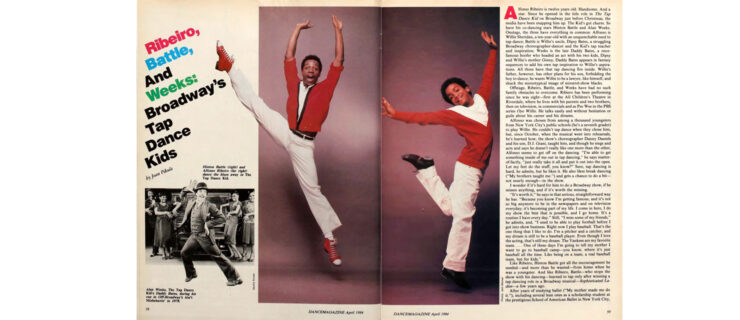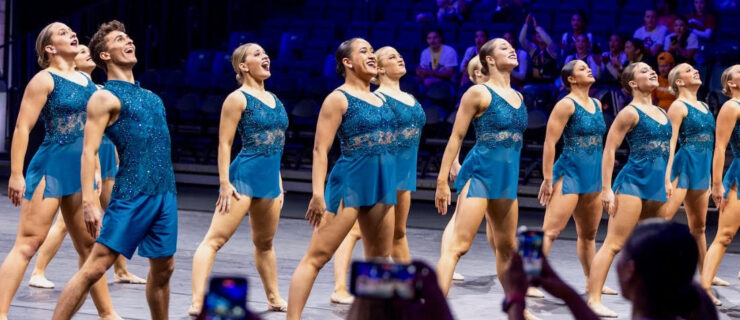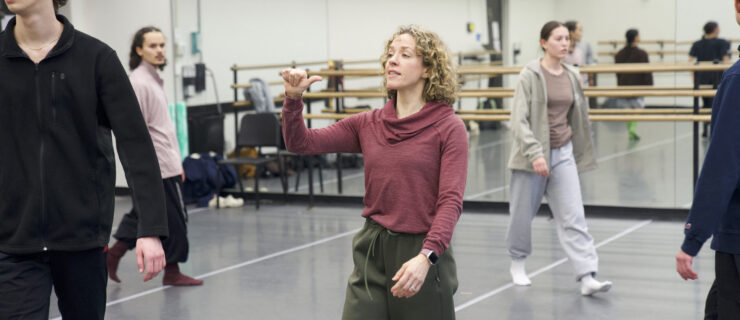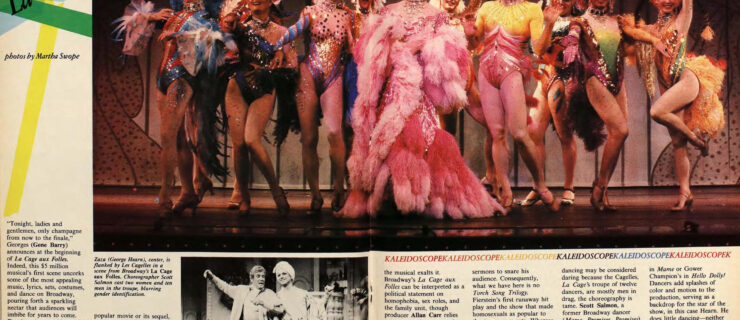Reliving Robbins
Nearly 10 years after his death, the imprint left by Jerome Robbins seems to have grown, rather than diminished. Four biographies have been written about his life—brilliant, creative, checkered, and troubled—but his choreography appears to matter now more than ever. An appetite for ballets that present dancers as people seems to be a trait of today’s dance audiences. New York City Ballet, his home company for many years, is planning productions of a staggering 33 Robbins ballets for the spring season, including revivals of the rarely seen Watermill, Four Bagatelles, and Les Noces. Meanwhile, Pacific Northwest Ballet, Paris Opéra Ballet, San Francisco Ballet, and The National Ballet of Canada have or will have presented all-Robbins programs this season. Robbins’ spirit still looms large.
“Whenever dancers perform a Jerome Robbins ballet, they all stress how much they enjoy the experience,” says Jean-Pierre Frohlich, the ballet master for the Robbins Rights Trust, who is overseeing all the City Ballet revivals this season. The opportunity to dig deeply and find new things about characters and about themselves matters a lot to performers. With modern classics that show startling range, from the idyllic Dances at a Gathering and the exuberant Fancy Free, to the sensual Afternoon of a Faun or the hilarious The Concert, the chance to allow artists to emerge from great art is ever present in the Robbins repertoire. For dancers who long to feel movement with meaning, the free spirits, romantic lovers, wandering sailors, alienated street kids, and murderous insects in Robbins’ works provide heady subjects.
Robbins’ process carries a lot of mythology, so it’s relevant to hear from those who worked closely with him to see what energized Robbins in the dance studio and how he extracted from dancers what he demanded.
Peter Boal, now artistic director of Pacific Northwest Ballet, got his first lessons from Robbins as a 10-year-old student at School of American Ballet, dancing Cupid in Mother Goose Suite. “He stopped the rehearsal and took the time to coach me on this two-minute role,” says Boal. “Immediately I got the idea that this was not a run-on part but deserved my time and intellectual effort. Since I was to lead Prince Charming to the fairy princess, he told me to be like an Indian scout who couldn’t snap twigs and scare anyone away. I really had to think.”
The legendary Chita Rivera, who created the role of Anita in Broadway’s West Side Story, says, “Jerry was hard, but that was a hard job. It was stuff that we had never done before. We could never have done it had he not pushed us to a point where we either did it or not. We were asked questions about our characters and had to come back with answers about our mothers’ names, what neighborhood we grew up in, how many brothers and sisters we had.” Robbins required acting improvisation from the dancers. For the scene where the Jets taunt Anita with racist insults, he let the dancers loose in emotional territory and stepped in only when it got out of control. “I never took an acting class,” adds Rivera. “But he talked about it from a point I understood. He allowed me to know myself better by directing me.”
The famous intensity of Robbins’ demeanor in rehearsals was a result of his relentless quest for perfection. “Many years after dancing in the original cast of West Side Story, I understood that working with geniuses is a challenge. They so rarely approve of themselves and their own work, so how in the heck do you expect them to approve of you?” says Grover Dale, who co-directed Jerome Robbins’ Broadway in 1988. “You can interpret that if you’re in front of him, he’s being critical of you. It’s not about you, it’s about him.”
Still, Rivera recalls that Robbins took Mickey Calin (the original Riff in West Side Story) and “knocked him down, molded him, and built him back up. His life was not a happy one during that show. But when the dancers listen and learn, they get the rewards afterwards.”
Robbins’ own ability to reproduce movement made him demand the same from his dancers. “He would demonstrate a lot and wanted the dancers to watch what he was doing,” says Frohlich, who remembers Robbins losing control and his yelling. On one occasion, when Glass Pieces received minimal rehearsal time, he started shouting at a new cast member who was off in her timing. He reduced her to a puddle of tears. “Afterwards, he was upset at himself and said, ‘I can’t believe I was screaming at that girl. You should have stopped me,’ ” says Frohlich.
But it is the details that make the magic in the ballets. When Robbins rehearsed Boal as the Boy in Brown in Dances at a Gathering, Boal decided Robbins was “thinking a lot about his own mortality” and the choreographer wanted correct coaching for the subsequent generation of dancers. The opening and closing moments of the ballet are pivotal. “At the start of the ballet, he walks in with his back to the audience and looks around. The moment has to be the whole memory returning, reflection, and the fact that major events happened in this space,” says Boal. Similarly, the last moment where he touches the earth (a gesture the choreographer could rehearse endlessly) is fully loaded. “After an hour of relationships, to ground it all in one touch is a challenge. It was never the touch. It was how you came away from the touch, trying to make the connection between the gesture and the thought behind it. It’s a place in time and something that stays with us that we learn from.”
Robbins appreciated a directness (but not rudeness) in dancers, particularly when so many were nervous around him. That’s because, Frohlich says, Robbins was honest with others: “You knew where you stood. If he wanted something from you, he expressed it right away. He didn’t wait three days. He didn’t play a game to see what you would do. He would just say, this is what I want and do it. He didn’t want to repeat himself three times.”
Rivera felt she was in tune with his choreographic instincts: “When something is really right, it feels good. If it’s right rhythmically and emotionally, I can learn it quickly.”
Because of his own impeccable punctuality, tardiness to rehearsals wasn’t tolerated. If a dancer was five minutes late, the dancer owed him five minutes. And anyone who hadn’t done their homework was toast. “We had many versions of one combination,” says Rivera. “And he would throw them at us and we had better be able to perform any of them.”
Challenging Robbins wasn’t a routine event, but it did occur. Dale told Robbins at a pre-Broadway run-through of Jerome Robbins’ Broadway at SUNY Purchase that the show should be performed in rehearsal clothes without sets, but Robbins didn’t agree. The Tony Award–winning show closed prematurely because of operating costs.
When Boal first rehearsed the demanding lead role of Opus 19: The Dreamer, Robbins said, “It’s not enough, I had greater expectations, but I just don’t think it’s going to work” and walked to the door. With split-second thinking, Boal convinced him to come back, that he could bring more to it, and eventually won Robbins’ approval. “Jerry was the only person I worked with in my career who didn’t always pat me on the back. He would say, ‘Not good enough.’ ”
The riches that Robbins gave to the worlds of dance and theater are still being assessed. He has influenced other choreographers like Christopher Wheeldon, Eliot Feld, and Susan Stroman. So what has really cemented his legacy?
“It’s the combination of the dancing and acting, combining the vernacular with ballet,” says Rivera. “He knew how to do romance and humor. He knew what a peasant man was thinking in Fiddler on the Roof. He knew slapstick, how to be grotesque and funny.” (Just think of the cigar-chomping, gallivanting husband in The Concert when he suddenly encounters his wife, arms folded, tapping her foot in utter disapproval.)
Dale agrees with the genius of his theatricality. “In the first 45 seconds of West Side Story, he shows them the inciting incident and delivers the show. I can’t think of another choreographer who’s done that.”
Frohlich believes that Robbins got audiences to relate to ballet in a way that made them feel comfortable. “He gave a sense of humanity to dance,” says Frohlich. “It was real people onstage looking at each other and walking normally. Fancy Free, to me, is not a ballet, it’s a play. He tells the story all in movement and pantomime. He had an amazing way of creating a sense of community and mood and atmosphere. That’s why it worked with Balanchine so well. They were complementary.”
Even in the more abstract works, like The Goldberg Variations, intimate relationships surface and dissolve through the use of gesture and intention. “For me,” says Boal, “the interaction, the contact with the eyes and hands, all those still moments have to be so rich.”
Robbins continually brought the outside world onto the ballet stage, whether through the cool, finger-snapping kids of New York Export: Opus Jazz, the interaction of gender roles in the silent Moves, the urban adrenaline of Glass Pieces, the Zen-like memories in Watermill, or the blend of romance and narcissism of Afternoon of a Faun. Ten years ago Jerome Robbins left this world, but his onstage world is still very alive. His works move us, disturb us, and tickle us. They conjure up an alternate universe of dreams.
Joseph Carman is a DM Contributing Editor and the author of Round About the Ballet.
Photo courtesy answersfordancers.com.




